

The Jazz Age and the Harlem Renaissance. Temporary: The Harlem Renaissance. Museum Kurá Hulanda has a continuing program of creating temporary exhibitions, as well as importing a variety of temporary exhibitions relevant to our themes and of interest to the public.
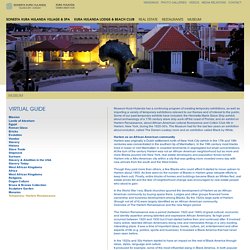
Some of our past temporary exhibits have included; the Henrietta Marie Slave Ship exhibit, about archaeology of a 17th century slave ship sunk off the coast of Florida; and an exhibit on Harlem Renaissance, about African-American cultural florescence and Cotton Club life in Harlem, New York, during the 1920-30's. The Museum had for the last two years an exhibition about evolution, called The Darwin-Leakey room and an exhibition called Black by White. Harlem as an African American community Harlem was originally a Dutch settlement north of New York City (which in the 17th and 18th centuries was concentrated in the southern tip of Manhattan). In the 19th century most blacks lived in lower or mid Manhattan in crowded tenements in segregated but small concentrations. 1. 2. 3. 5. 6.
Plum bun : a novel without a moral : Fauset, Jessie Redmon. Rachel, a play in three acts : Grimke, Angelina Weld, 1880- Cultural Leaders and Harlem Renaissance Famous People flashcards. The New Negro Renaissance. When Langston Hughes left his native Midwest to attend Columbia University in 1921, he was excited about his new school's location in the Harlem community.

Hughes had already heard about a place that was the "Negro capital of the world," and he knew that if ever he wanted to be a writer, his career would have to begin in Harlem. Hughes would become one of the major figures in the New Negro Renaissance—or Harlem Renaissance, as it is familiarly known. After his arrival, he would never call anyplace else home, and in many ways Hughes typifies what the Renaissance meant and what it allowed. Today his residence at 20 East 127th Street continues to attract young writers committed to producing the kind of art that made Hughes famous. It remains the period to which we attribute the development, if not the birth, of every major artistic and literary form that we now associate with African-American life and culture.
The Great Migration Back to top Mixing Various Traditions. The Harlem Renaissance. The Savoy Ballroom in Harlem in 1926 was The Place and Lindy Hop was The Dance!
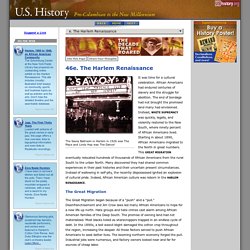
It was time for a cultural celebration. African Americans had endured centuries of slavery and the struggle for abolition. The end of bondage had not brought the promised land many had envisioned. Instead, white supremacy was quickly, legally, and violently restored to the New South, where ninety percent of African Americans lived. Starting in about 1890, African Americans migrated to the North in great numbers. Art and Culture of the Harlem Renaissance: Artists, Poets, Authors & Music.
In this lesson we will learn about an artistic and intellectual movement called the Harlem Renaissance.
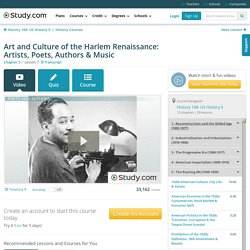
We will identify the major figures associated with the movement, and identify their contributions. Explore our library of over 10,000 lessons Click "next lesson" whenever you finish a lesson and quiz. Got It You now have full access to our lessons and courses. You're 25% of the way through this course! Way to go! Congratulations on earning a badge for watching 10 videos but you've only scratched the surface.
You've just earned a badge for watching 50 different lessons. You have earned a badge for watching 20 minutes of lessons. You have earned a badge for watching 50 minutes of lessons. You have earned a badge for watching 100 minutes of lessons. You have earned a badge for watching 250 minutes of lessons. You have earned a badge for watching 500 minutes of lessons. Black History Month: Experiencing the Harlem Renaissance Today – The Hub. As we celebrate Black History Month, let’s reflect on one of the most culturally significant time periods of African American history: the Harlem Renaissance.
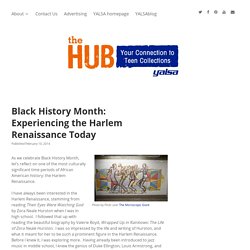
I have always been interested in the Harlem Renaissance, stemming from reading Their Eyes Were Watching God by Zora Neale Hurston when I was in high school. I followed that up with reading the beautiful biography by Valerie Boyd, Wrapped Up in Rainbows: The Life of Zora Neale Hurston. I was so impressed by the life and writing of Hurston, and what it meant for her to be such a prominent figure in the Harlem Renaissance. Before I knew it, I was exploring more. Sports and Important Athletes during the Harlem Renaissance by William Valentine on Prezi.
List of people from Harlem. From Wikipedia, the free encyclopedia This is a list of people from Harlem in New York City.
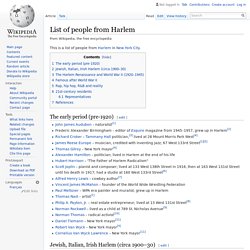
The early period (pre-1920)[edit] Jewish, Italian, Irish Harlem (circa 1900–30)[edit] The Harlem Renaissance and World War II (1920–1945)[edit] Famous after World War II[edit] Rap, hip hop, R&B and reality[edit] 21st-century residents[edit] Kareem Abdul-Jabbar – basketball player, moved into a Mount Morris brownstone at 30 West 120th Street[73] in September 2006[74]Lorraine Adams – writer and journalist[75]Maya Angelou – poet and author, owned a home on 120th Street in Mount Morris Park district. Before going to live and work in China, India and throughout Europe Representatives[edit]
The Harlem Renaissance - Home. Famous Harlem Renaissance People.